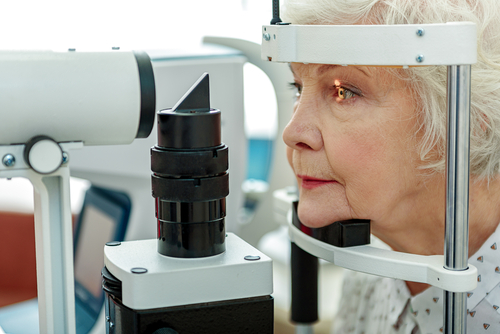Posted by: Eye Health Northwest in Glaucoma, Uncategorized on June 16, 2023

Often called “the silent thief of sight,” glaucoma is a serious eye condition that can go unnoticed due to the fact that it causes gradual vision changes. That’s why a comprehensive eye exam is essential to protect your vision and eye health.
Keep reading to learn more about glaucoma, including how it’s diagnosed!
What Do Eye Doctors Look For When Diagnosing Glaucoma?
There are several methods eye doctors use to diagnose glaucoma. Typically they will look for three things: elevated eye pressure, changes in the optic nerve, and changes in the visual field.
Elevated Eye Pressure
This means that the pressure inside the eye, called intraocular pressure or IOP, is higher than normal. When your eye pressure is elevated, it can impact the optic nerve by damaging the tiny nerve fibers that comprise the optic nerve.
Changes in the Optic Nerve
The optic nerve is what carries signals from your eye to your brain and is very important for vision. Changes in the optic nerve show that damage has occurred and that glaucoma is present.
Changes in the Visual Field
Changes in your visual field can include loss of sight in the peripheral or side vision. Because these blind spots are less noticeable, the individual with glaucoma may not realize they’re developing.
As glaucoma worsens, central vision can be affected. Since the damage done by glaucoma is irreversible, early detection and treatment are critical to prevent permanent vision loss.
How Do Eye Doctors Look For Glaucoma?
There are a variety of ways eye doctors evaluate a person’s eyes for glaucoma.
Comprehensive Eye Exam
Eye doctors can determine the presence of glaucoma during a comprehensive eye exam using various testing methods. During this exam, patients are given drops to dilate their pupils so the eye doctor can look within the eye to carefully examine the structures at the back of the eye.
This includes optic nerve evaluation, which is essential for diagnosing glaucoma.
Tonometry
Tonometry measures the inside pressure of your eye. This can be done in a variety of ways and is very important for diagnosing and monitoring glaucoma as well as evaluating how well glaucoma treatment is working.
Optical Coherence Tomography (OCT)
OCT is a machine that takes high-resolution cross-section pictures of the retina at the back of the eye. The result is a 3D image of the layers of the retina and optic nerve.
This enables early detection of a number of possible conditions, including glaucoma.
Visual Field Testing
This test determines if there are areas of your vision that have been damaged. Typically, glaucoma first causes damage to the peripheral vision.
After a visual field test, your eye doctor will be able to see exactly where your vision may have been damaged from glaucoma.
Your eye doctor will use a combination of these tests to determine whether or not you have glaucoma. If you have a family history of the condition, it is even more important that you have your eyes checked regularly.
Are you experiencing symptoms of glaucoma? Schedule an appointment at EyeHealth Northwest in Portland, OR, today!

